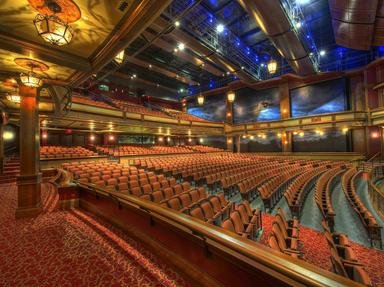Quiz Answer Key and Fun Facts
1. "Girl Crazy" (1930) starred Ginger Rogers, but a former stenographer from Queens, New York stole the show. Who was it?
2. Which Broadway show of the 1930s was the first musical to win the Pulitzer Prize for Drama?
3. True vaudeville had vanished by the early 1930s, but revues were still going strong. In which show did Fred and Adele Astaire go "Dancing in the Dark" in their final Broadway appearance together?
4. Broadway legend George M. Cohan sang and danced his way through Rogers & Hart's 1937 musical, "I'd Rather Be Right". It was a strange role for a familiar star. Whom did he play?
5. George Gershwin's "Porgy and Bess" (1935) was more opera than musical. Who wrote the straight play from which it was adapted?
6. Which long-running musical revue of the 1930s opened with an all-amateur cast?
7. "Mad Dogs and Englishmen" became a trademark number for the fabulously talented Beatrice Lillie. Noel Coward wrote it, of course my dear, but for which 1930s revue?
8. Berlin to Broadway! "Threepenny Opera" (German premiere 1928) was a major hit at the Theater am Schiffbauerdamm. It came to Broadway in an English translation in 1933. How did the show fare in America?
9. "After You, Who?" Bereft of sister Adele, Fred Astaire made his final Broadway appearance in which 1930s musical?
10. Something Went. Cole Porter's brilliant "Anything Goes" (1934) might have been even better. Which classic song was written for the show, but was cut during rehearsals?
11. The Beginning of the Beguine. Which Cole Porter musical featured "Begin the Beguine" and "Just One Of Those Things"?
12. A Really Big Show. Rodgers and Hart's "Jumbo" (1935) featured circus acts, Jimmy Durante, and a live elephant with an even bigger nose. The best-known song from the show wasn't particularly circus-themed. What was it?
13. You Must Remember This. Dooley Wilson, Humphrey Bogart, "Casablanca" (1942) ... but the song was actually written for a 1931 Broadway show. Who composed "As Time Goes By"?
14. Musical revivals were rare in the 1930s. "Showboat" closed in 1929 but returned to Broadway in 1932 - this time with a star Jerome Kern wanted for the original production. Who was it?
15. Ethel Merman sang the duet "It's De-Lovely" in Cole Porter's 1936 musical "Red, Hot and Blue". Who sang it with her?
16. The song "Easter Parade" is best-remembered today through the 1948 Judy Garland-Fred Astaire movie of the same name. For which Broadway show of the 1930s was it written?
17. Busby Berkeley (1895-1976) choreographed some of the great "backstage musical" movies of the 1930s, including "42nd Street" and "Footlight Parade". Did he ever choreograph a Broadway show before going to Hollywood?
18. "My Heart Belongs to Daddy." In which Cole Porter musical did Mary Martin make her Broadway debut?
19. "Little Johnny Jones" (1904) and over a dozen more shows by George M. Cohan; Irving Berlin and the Marx Brothers in the 1920s; the Gershwins and Cole Porter and Rogers & Hart in the 1930s; over a hundred musicals and straight plays from 1903 to 1941. Who produced them all?
20. There were no Tony Awards until 1947, but the organization that confers them was founded under its present name in 1939. What is it?
Source: Author
ignotus999
This quiz was reviewed by FunTrivia editor
looney_tunes before going online.
Any errors found in FunTrivia content are routinely corrected through our feedback system.

